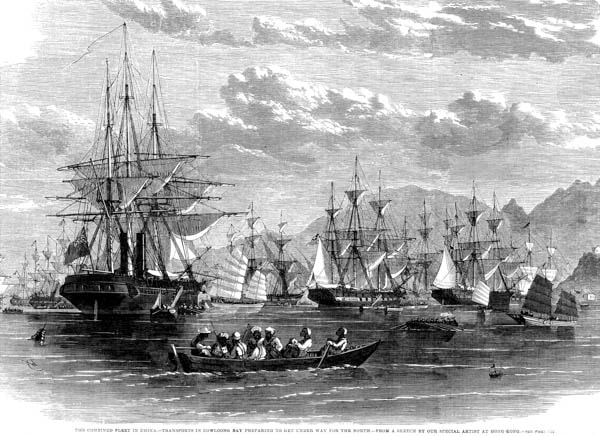The Second Opium War is also known as the Anglo-French Expedition or the Arrow War. The causes of the war were far-ranging and complicated. In general, the British were dissatisfied with what they had achieved from the Treaty of Nanjing and wanted to gain more concessions, including the opening of more ports in China for trade, the legalisation of the opium trade, and above all, the imposition upon China of the most-favoured nation principle. Tension was mounting in the 1850s, reaching a head in October 1856, when a Chinese-owned Hong Kong-registered lorcha was seized by Chinese authorities in Guangzhou and the crew were imprisoned on allegations of piracy. Rumours spread at the time that the British flag had been pulled down during the incident, an act that was regarded as an insult to the British Crown. (It was later revealed that the registration of the vessel had expired at the time of the incident.[1]) Using this as an excuse, the British attacked Guangzhou and waged war on China. Meanwhile, a French Mission Entrangere priest was executed in Guangxi, and this incident prompted the French to join the military campaign. The first phase of the war concluded with the Treaty of Tianjin in June 1858.
However, hostilities were renewed in 1860. The British and French were reinforced and launched an attack on the capital. They occupied Beijing and burnt down Yuan Ming Yuan. The war ended with the signing of the Convention of Beijing ceding Kowloon Peninsula to Britain. Clauses also included the legalisation of the opium trade, the opening of Tianjin as a treaty port, and permission for British ships to carry indentured labour to the Americas.[2]
From the day Hong Kong Island was occupied in 1841 by the British to 1859, Kowloon Peninsula had remained a part of Chinese territories and had been governed by the Chinese government. It essentially became a buffer area between the British Government in Hong Kong and the Chinese garrison at Kowloon City, and Sir John Davis remarked that it was considered a kind of “neutral ground”.[3] The British were keen to extend their territories and to obtain complete control of the harbour through the annexation of Kowloon Peninsula. The Governor, Sir John Bowring, pressed the Home Office to acquire Kowloon Peninsula for military, commercial, sanitary, and police purposes.[4] But the annexation of the peninsula was not included in the Treaty of Tianjin in 1858. Bowring was instructed to negotiate for a lease of Kowloon Peninsula with the Governor of Guangdong. However, hostilities resumed and the war ended with the signing of the Convention of Beijing, which stipulated the annexation of Kowloon Peninsula south of Boundary Street and Stonecutters Island. Henceforth, the colonial government acquired full control of Victoria Harbour. The Second Opium War had other consequences. The burning of the factories in Guangzhou in 1856 led firms stationed there to move their headquarters to Hong Kong, bringing with them their Chinese compradors.[5] They provided the capital, expertise and experience for the development of trade in the later part of the 19th century.
Notes:
- [1]G. B. Endacott, A History of Hong Kong (Hong Kong: Oxford University Press, 1964), p. 91.
- [2]A Century of Resilient Tradition: Exhibition of the Republic of China's Diplomatic Archives (Taipei: National Palace Museum, 2011), pp. 24-25.
- [3]Endacott, A History of Hong Kong, p. 109.
- [4]Ibid.
- [5]Solomon Bard, Traders of Hong Kong: Some Foreign Merchant Houses, 1841-1899 (Hong Kong: Urban Council, 1993), p. 44.
Part 1 Chapter 3.1 - The Second Opium War and the annexation of Kowloon Peninsula



